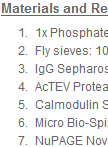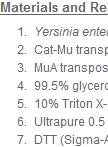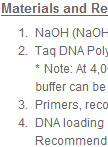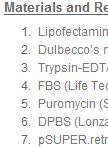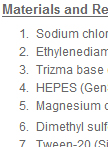Improve Research Reproducibility A Bio-protocol resource
- Protocols
- Articles and Issues
- About
- Become a Reviewer
Past Issue in 2012
Volume: 2, Issue: 15
Developmental Biology
Tandem Affinity Purification in Drosophila Heads and Ovaries
Tandem affinity purification (TAP) (Pugi et al.,2001; Rigaut et al., 1999) is a method that uses a tagging approach of a target protein of interest for a two-step purification scheme in order to pull down protein complexes under native conditions and expression levels. The TAP tag consists of three components: a calmodulin-binding peptide, a Tobacco etch virus (TEV) protease cleavage site and Protein A which is an immunoglobulin G (IgG)-binding domain. This protocol was modified from the original methodology used in yeast cells(Pugi et al.,2001; Rigaut et al., 1999) for isolation of protein complexes from Drosophila heads and ovaries expressing a TAP tagged protein of interest. To determine in vivo binding partners of the Drosophila fragile X protein (dFMR1), we developed a transgenic strain of flies expressing a recombinant form of dFMR1 with a carboxy-terminal TAP tag (Tsai and Carstens, 2006). To ensure that the construct was expressed at wild-type levels, we engineered this form of the tagged protein in the context of a genomic rescue construct that rescued a mutant sterility phenotype. The purification process was performed using mild conditions to maintain native protein interactions. For TAP methods in Drosophila S2 cell culture, we have successfully used a protocol previously published by Tsai and Carstens (Tsai and Carstens, 2006; Bhogal et al., 2011).
Microbiology
Construction and Screening of a Transposon Insertion Library of Yersinia enterocolitica (YeO3-R1)
The Mu-transposon system is one of the best characterized transposition systems. Under minimal in vitro set-up, Mu transposition requires only a simple reaction buffer, MuA transposase protein, mini-Mu transposon DNA (donor) and target DNA. The reaction proceeds via initial assembly of the transposition complex that directs transposon integration into target DNA with high efficiency and relatively low target site selectivity. These characteristics make the Mu in vitro transposition technology ideal for the generation of comprehensive mutant DNA libraries usable in a variety of molecular biology applications. This technology has successfully been used for DNA sequencing, functional analyses of plasmid DNA and virus genomes, protein engineering for structure/function and protein-protein interaction studies and generation of gene targeting constructions. When electroporated, the in vitro–assembled Mu transposition complexes can also be used for efficient gene delivery in bacteria, yeasts and mammalian cells. Using this protocol we have identified several mutants where Cat-Mu insertion has interrupted genes involved in lipopolysaccharide (LPS) biosynthesis (Pinta et al., 2012).
Molecular Biology
A Quick, No Frills Approach to Mouse Genotyping
Mice are extremely powerful mammalian genetic model organisms for basic and medical research, but managing a colony of transgenic mice is time consuming and expensive, many times requiring the help of dedicated technicians. Slow and laborious genotyping procedures add to the hassle. Outsourcing is costly and may not be as fast as desired, especially when setting up time sensitive experiments. Ultrafast genotyping protocols often require real-time PCR instruments and commercial reagents that may not be economical or practical. This protocol, adapted from methods suggested by The Jackson Laboratory, employs a minimalist approach that maximizes convenience by simplifying the tissue digestion/DNA extraction process and using a high-speed electrophoresis system for sample analysis. Genotype PCR results can be obtained in 3 h or less for as many samples as can fit in a PCR machine or can be efficiently handled by a user. Subsequent ethanol or chloroform purified DNA can be used in a standard PCR reaction to roughly identify a homozygous and a hemizygous mouse.
Stable Interference by shRNA with pSUPER.retro Vectors and Lipofectamine
RNA interference is a powerful genetic approach for efficiently silencing target genes. Expression of short hairpin RNAs (shRNAs) allows analysis of the consequences of stably silencing genes. This protocol describes a method to stably integrate shRNA constructs with pSUPER.retro vectors and Lipofectamine in RKO and H1299 cells. This method can be applied to cells from other lines with modification of drug selection and cell conditions. pSUPER.retro vectors can be also transfected into packaging cells by this same method to produce retroviral supernatants.
5-Hydroxymethylcytosine (5-hmC) Specific Enrichment
5-Hydroxymethylcytosine (5-hmC) is a newly discovered DNA modification in mammalian genomes. This protocol is to be a highly efficient and selective chemical approach to label and capture 5-hmC, taking advantage of a bacteriophage enzyme that adds a glucose moiety to 5-hmC specifically, which could in turn be used for high-throughput mapping via next-generation sequencing.


